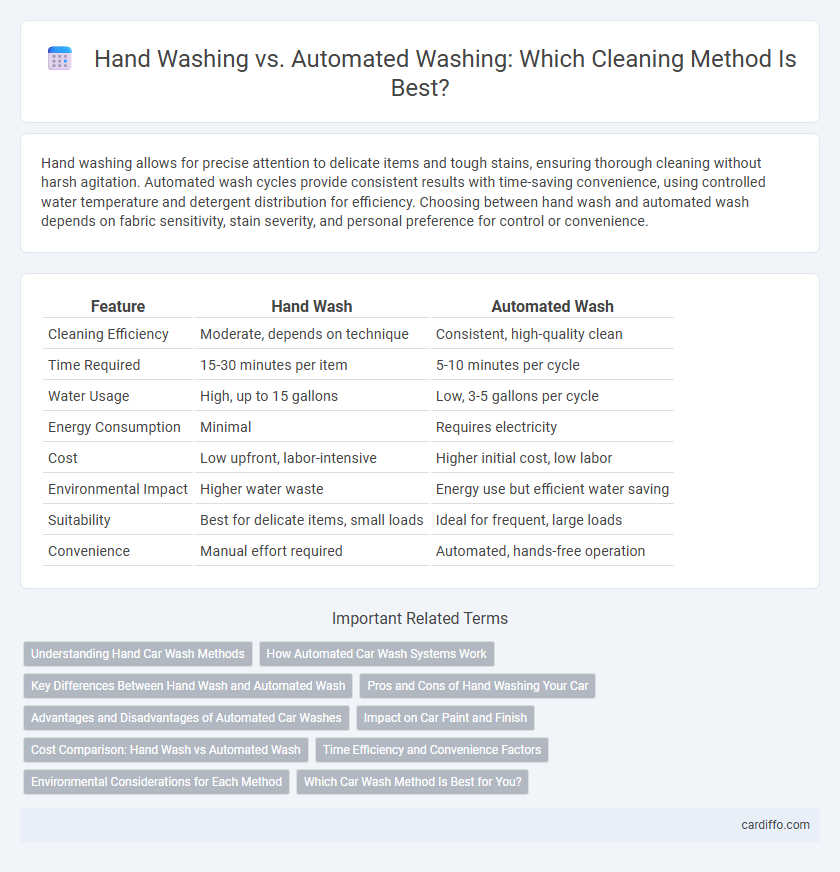Hand washing allows for precise attention to delicate items and tough stains, ensuring thorough cleaning without harsh agitation. Automated wash cycles provide consistent results with time-saving convenience, using controlled water temperature and detergent distribution for efficiency. Choosing between hand wash and automated wash depends on fabric sensitivity, stain severity, and personal preference for control or convenience.
Table of Comparison
| Feature | Hand Wash | Automated Wash |
|---|---|---|
| Cleaning Efficiency | Moderate, depends on technique | Consistent, high-quality clean |
| Time Required | 15-30 minutes per item | 5-10 minutes per cycle |
| Water Usage | High, up to 15 gallons | Low, 3-5 gallons per cycle |
| Energy Consumption | Minimal | Requires electricity |
| Cost | Low upfront, labor-intensive | Higher initial cost, low labor |
| Environmental Impact | Higher water waste | Energy use but efficient water saving |
| Suitability | Best for delicate items, small loads | Ideal for frequent, large loads |
| Convenience | Manual effort required | Automated, hands-free operation |
Understanding Hand Car Wash Methods
Hand car wash methods involve manual scrubbing with sponges, microfiber cloths, and biodegradable soaps that effectively remove dirt and grime while being gentle on the vehicle's paint. This technique allows for targeted cleaning of intricate areas such as wheel wells and door jambs, ensuring a thorough wash. Hand washing reduces the risk of swirl marks and paint damage often caused by automated brushes, preserving the car's finish and shine.
How Automated Car Wash Systems Work
Automated car wash systems use a series of mechanical brushes, high-pressure water jets, and detergents to efficiently clean vehicles without manual labor. Sensors guide the vehicle through various cleaning stages, adjusting spray patterns and brush movements to ensure thorough coverage while minimizing water use. This process offers a faster, consistent wash compared to traditional hand washing, reducing the risk of scratches and saving time.
Key Differences Between Hand Wash and Automated Wash
Hand wash offers thorough control over cleaning intensity, allowing targeted attention on delicate or heavily soiled areas, whereas automated wash provides consistent cleaning cycles with programmable settings enhancing efficiency and repeatability. Hand washing requires more time and labor but ensures personalized care, while automated systems save time and reduce manual effort through mechanical processes and detergents optimized for machines. Choosing between hand wash and automated wash depends on factors like fabric type, cleaning precision needed, time availability, and overall cost-effectiveness.
Pros and Cons of Hand Washing Your Car
Hand washing your car allows for meticulous attention to detail, preventing damage to paintwork and reaching areas neglected by automated washes, but it demands significant time and physical effort. This method reduces the risk of scratches often caused by abrasive brushes in automated systems but increases the possibility of inconsistent water pressure and cleaning solution use. While hand washing is environmentally friendly when using controlled amounts of water and biodegradable soaps, it can be less efficient in water consumption compared to modern touchless automated wash systems.
Advantages and Disadvantages of Automated Car Washes
Automated car washes offer significant time savings and consistent cleaning quality through advanced sensors and high-pressure water jets, reducing manual effort and water waste. However, they may cause minor paint scratches due to brushes and lack the thoroughness of hand washing in removing stubborn dirt and debris from hard-to-reach areas. The convenience of automated washes is balanced by the potential for mechanical wear on vehicles and limited customization compared to hand wash methods.
Impact on Car Paint and Finish
Hand washing preserves car paint more effectively by minimizing abrasion and reducing the risk of swirl marks often caused by automated brushes. Automated washes use rotating brushes and harsh detergents that can degrade paint finishes and accelerate clear coat wear over time. Many professional detailers recommend hand washing with microfiber mitts and pH-neutral soaps to maintain the car's optimal gloss and paint protection.
Cost Comparison: Hand Wash vs Automated Wash
Hand washing vehicles typically incurs higher labor costs due to the time-intensive nature of manual cleaning and the use of premium cleaning products, which can escalate expenses. Automated washes offer a more cost-effective solution by reducing labor requirements and increasing throughput, resulting in lower per-vehicle cleaning costs. However, the initial investment and maintenance expenses of automated systems should be factored into long-term cost analyses to determine overall economic efficiency.
Time Efficiency and Convenience Factors
Hand wash offers precise control over cleaning delicate items but requires significantly more time and physical effort compared to automated wash systems. Automated wash machines deliver faster cycle times and consistent results, maximizing time efficiency while minimizing manual labor. Convenience factors favor automated washing with programmable settings and unattended operation, allowing users to multitask during cleaning cycles.
Environmental Considerations for Each Method
Hand washing typically consumes more water per cycle compared to automated washes, especially when done inefficiently. Automated washing machines often use regulated water and energy cycles, reducing resource consumption and minimizing wastewater runoff. Choosing energy-efficient models and eco-friendly detergents further lessens the environmental impact of automated washing compared to manual hand wash methods.
Which Car Wash Method Is Best for You?
Hand wash car cleaning offers meticulous attention to detail, ideal for removing stubborn dirt and protecting delicate paint finishes. Automated wash systems provide convenience, speed, and consistent cleaning quality with advanced brushes and high-pressure jets. Choosing the best method depends on your vehicle's condition, time availability, and preference for thorough care versus efficient maintenance.
Hand Wash vs Automated Wash Infographic

 cardiffo.com
cardiffo.com